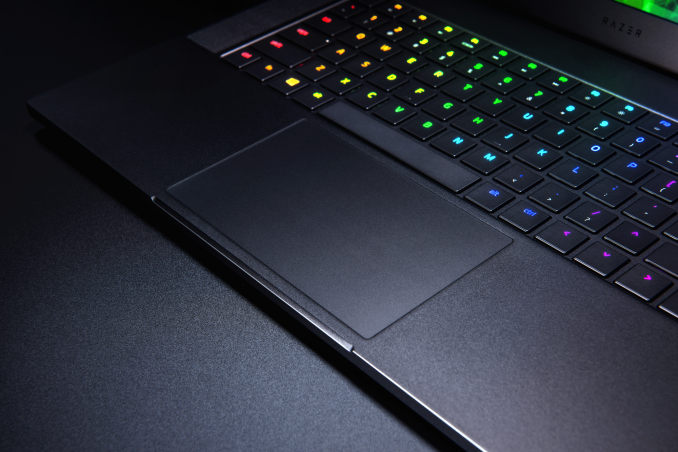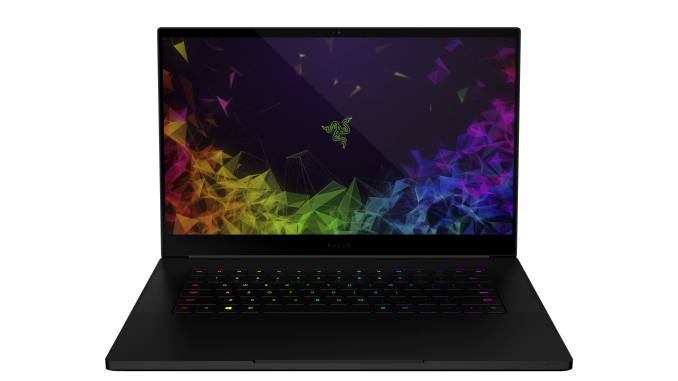Razer Launches The Razer Blade 15.6
by Brett Howse on May 22, 2018 3:01 AM EST- Posted in
- Laptops
- Razer
- Razer Blade
- eGFX
- Max-Q

Today Razer is taking the wraps off a new model in their lineup. The Razer Blade 15.6 slots in as a replacement for the 14, and boasts some features we’ve not seen in the rest of their lineup yet. They’ll be offering it in a variety of configurations, with different displays, and either a NVIDIA GTX 1060 Max-Q, or GTX 1070 Max-Q GPU.
Razer has done a fantastic job of taking their best-in-class CNC aluminum chassis and evolving it to keep it fresh. With the 15.6, it’s what you’d expect in a Razer Blade: thin and light. It also boasts some very narrow bezels, at just 4.9 mm, but with the top bezel slightly larger to accommodate the webcam in the correct location. Razer has moved to a clickable touchpad, letting them add a slightly larger one as well, and it ships with Precision drivers. And to fit in with the rest of the thin lineup, the GTX 1060 model is just 16.8 mm thick, while the GTX 1070 is only a half millimeter thicker. Weight is 2.07 – 2.15 kg (4.56 – 4.73 lbs) depending on the specs.
Let’s talk about specs. The Razer Blade 15.6 is shipping with the Intel Core i7-8750H CPU as the only processor option. This offers six cores, twelve threads, and up to 4.1 GHz of turbo. It’s shipping with 16 GB of DDR4, although the system will be offered with32 GB as well. The base SSD is a 512 GB PCIe model, with up to 2 TB available. GPU options, as mentioned, are either GTX 1060 or 1070 Max-Q models, which should offer good performance but thermals that this thin laptop can support.
| Razer Blade 15.6 | |||||
| Models | GTX 1060 | GTX 1070 | |||
| CPU | Intel Core i7-8750H 6 Cores, 12 Threads 2.2 GHz - 4.1 GHz, 45W TDP |
||||
| RAM | 16 GB - 32 GB DDR4-2667 | ||||
| GPU | NVIDIA GTX 1060 Max-Q 1280 CUDA Cores 6 GB GDDR5 192-bit |
NVIDIA GTX 1070 Max-Q 2048 CUDA Cores 8 GB GDDR5 256-bit |
|||
| Storage | 512 GB - 2 TB PCIe NVMe SSDs | ||||
| Display | 1920x1080 60Hz IPS matte 1920x1080 144Hz IPS matte (optional) 3840x2160 60Hz IPS with touch factory calibrated displays |
||||
| Wireless | Intel Wireless-AC 9260 802.11ac 160MHz channel support MU-MIMO 2x2:2 Bluetooth 5 |
||||
| Connectivity | Thunderbolt 3 USB-C x 1 USB 3.0 x 3 mDP 1.4 x 1 HDMI 2.0b x 1 |
||||
| Battery | 80 Wh 200 W Adapter |
80 Wh 230 W Adapter |
|||
| Dimensions | 355 x 325 x 16.8 mm 14 x 9.3 x 0.66 inches |
355 x 235 x 17.3 mm 14 x 9.3 x 0.68 inches |
|||
| Weight | 2.07 kg / 4.56 lbs (non-touch) 2.15 kg / 4.73 lbs (touch UHD) |
||||
| Price | $1899.99 and up | $2399.99 and up | |||
There’s plenty of connectivity as well, and starting with wireless, Razer has gone back to an Intel Wireless solution with the latest generation Intel Wireless-AC 9260. Razer had been using Killer Wireless for the last couple of generations, but interestingly they’ve moved back to an Intel one when Killer is also using this same NIC as the platform for their 1550. But regardless, the 9260 is a solid looking update over the 8260, with the same 2x2:2 configuration, but adding support for 160 MHz channels as well, so the max connection rate is now 1.73 Gbps if your router has 160 Mhz available. Razer is of course also offering Thunderbolt 3 on a USB-C port, which is required for their eGFX enclosures, including the just launched Razer Core X. In addition, there’s three USB 3 ports, mini DisplayPort 1.4, and HDMI 2.0b.
Razer is offering three display choices as well, to hit a wider range of client needs. The base model is a 60 Hz 1920x1080 display, but for those that want nothing but smoothness, you can also move to a 144 Hz 1920x1080 panel with 100% sRGB coverage. For those that want clarity at the expense of refresh rate, there’s also a 3840x2160 panel offered with a 60 Hz refresh, and 100% Adobe RGB support. And, Razer is now individually calibrating each panel at the factory which should improve panel performance tremendously. That’s fantastic to see, since Razer tends to be on the premium end of the price range.
Battery life should be decent as well, since the laptop ships with an 80 Wh capacity, and it includes NVIDIA Optimus support to bypass the GPU when its not needed. For charging, it ships with either a 200-Watt, or 230-Watt adapter, depending on the GPU.
And in case you aren’t up on the standard features on the Razer laptop lineup, the new 15.6-inch model also comes with per-key RGB lighting, which can be controlled with Razer’s Chroma software, and the keyboard is also anti-ghosting. The stereo speakers flank the keyboard, offering forward facing audio as well.
Razer is yet again offering one of the nicest looking gaming laptops around, and it’s packed with the latest tech too. It’s great to see them move to calibrated displays, highlighting the premium nature of their lineup. Their lineup now offers a wide variety of models, which should let them attract more of the market than before. We’re hoping to get a review unit for this new model soon, so stay tuned.
Source: Razer













20 Comments
View All Comments
DanNeely - Tuesday, May 22, 2018 - link
Looking at Razer's website I think this is replacing the 14" model, not slotting in above it. Their laptop page only lists 13, 15, and 17" models, and the 13" model is just a razer styled ultrabook not a light gaming model with an MX150 or GT1050 GPU.Sadly the 4k display appears to only be available in the most expensive config which starts at $2899 with a 1070, 32gb ram, and a 512gb SSD.
Valantar - Tuesday, May 22, 2018 - link
I really wish they'd follow this up with a smaller "intro" model - ~13" with a U-series CPU (preferably @25W) and something like a GTX1050. Or, heck, why not Kaby Lake-G? Don't care at all if it would be a bit thick by today's 13" ultrabook standards, as long as the design tapered a bit at the edges. If Dell can successfully cool 25W worth of CPU power in the XPS 13, it really shouldn't take a much thicker design to double that cooling capacity - or just make the device ever so slightly larger to accommodate bigger heatsinks.jeremyshaw - Tuesday, May 22, 2018 - link
Except Dell isn't successfully cooling 25W of TDP in the XPS13. Compare it to another laptop with the same CPU, like a larger T480, and suddenly, the same CPU performs much better. Dell did set 25W as the TDP limit, but their poor thermal sensor placement means the CPU will thermally throttle long before that ever happens, and the fans are deliberately slow to ramp up. The thermal insulation pad + the slow fan gives the impression to some end users that the XPS 13 is actually running cool and quiet, but the reality is downclock, downclock, downclock.id4andrei - Tuesday, May 22, 2018 - link
Isn't Max-Q a compromise from a performance perspective? You're basically paying for thinness. Once the thermal throttling kicks in over the already throttled Max-Q GPU, that 1900$ investment(pre-tax) doesn't sound so good now, does it?ImSpartacus - Tuesday, May 22, 2018 - link
Yes, Max-Q is effectively traditional mobile parts in that they move down to a more efficient part of the voltage curve.limitedaccess - Tuesday, May 22, 2018 - link
1080p 144hz IPS panels available for laptops but none for desktops.peterfares - Wednesday, May 23, 2018 - link
Really? I got a 1440p 144Hz IPS monitor, someone must make a 1080p one.eiskafee - Tuesday, May 22, 2018 - link
I have been using Razer Blade 14 as a primary machine for the last 3 years and 2 months. While I am drooling over this new machine, I have reservations.My Blade 14 has become SUPER loud and I have tried everything from under-volting, cleaning fans consistently, keeping it on a cooler surface but once I open a few browser windows and Photoshop, it kicks off like a jet engine. This is very embarrassing in a meeting.
Battery died within 2 years and I had to get it replaced, which was expensive and took time. The charger also got burned once but Razer was nice enough to ship me one for free, both left and right mouse buttons on the trackpad broke within 2 years. 3 months ago the backlight stopped working and it's one of the most expensive things to fix.
I am happy to spend $3000+ on this beauty if Razer promised at least 3 years full-time warranty.
BMNify - Tuesday, May 22, 2018 - link
Three years warranty is for plebs, this is luxury product for the rich and as such buying a new one after every year or two should not be a problem.Retycint - Tuesday, May 22, 2018 - link
>It is super loud
Well of course it is, that's the trade-off of cramming a full sized 1060 and a 45W quad core into such a thin and light form factor. Its major competitors i.e. Aero 14/15 and the new MSI GS65 is equally as loud.
Anyway, no other major manufacturer that I know of offers a 3-year manufacturer (not retailer) warranty as standard (excluding boutique brands like Origin, Xoticpc etc). In fact most brands only offer 1 year as standard